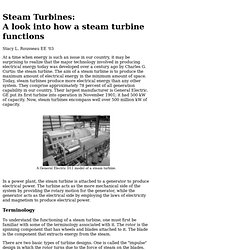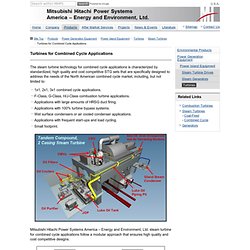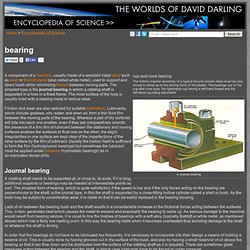

Look into Steam Turbine Functions. Stacy L.

Rousseau EE '03 At a time when energy is such an issue in our country, it may be surprising to realize that the major technology involved in producing electrical energy today was developed over a century ago by Charles G. Curtis: the steam turbine. The aim of a steam turbine is to produce the maximum amount of electrical energy in the minimum amount of space. Today, steam turbines produce more electrical energy than any other system. A General Electric D11 model of a steam turbine. In a power plant, the steam turbine is attached to a generator to produce electrical power. Terminology To understand the functioning of a steam turbine, one must first be familiar with some of the terminology associated with it.
There are two basic types of turbine designs. A single-flow turbine design has steam entering at one end. Functioning Steam is first heated in a boiler, where it reaches a temperature of approximately 1,000 °F. Steam turbine. The rotor of a modern steam turbine used in a power plant Because the turbine generates rotary motion, it is particularly suited to be used to drive an electrical generator – about 90% of all electricity generation in the United States (1996) is by use of steam turbines.[2] The steam turbine is a form of heat engine that derives much of its improvement in thermodynamic efficiency from the use of multiple stages in the expansion of the steam, which results in a closer approach to the ideal reversible expansion process.

History[edit] Diagram of an AEG marine steam turbine circa 1905 A 250 kW industrial steam turbine from 1910 (right) directly linked to a generator (left). A number of other variations of turbines have been developed that work effectively with steam. The Brown-Curtis turbine, an impulse type, which had been originally developed and patented by the U.S. company International Curtis Marine Turbine Company, was developed in the 1900s in conjunction with John Brown & Company. And. Turbines for Combined Cycle Applications : Hitachi Power Systems America, Ltd. The steam turbine technology for combined cycle applications is characterized by standardized, high quality and cost competitive STG sets that are specifically designed to address the needs of the North American combined cycle market, including, but not limited to: 1x1, 2x1, 3x1 combined cycle applications.

F-Class, G-Class, H/J-Class combustion turbine applications. Applications with large amounts of HRSG duct firing. Applications with 100% turbine bypass systems. Wet surface condensers or air cooled condenser applications. Mitsubishi Hitachi Power Systems America – Energy and Environment, Ltd. steam turbine for combined cycle applications follow a modular approach that ensures high quality and cost competitive designs.
Performance Range*: Output Range: 150-450 MW Normal Back-pressure: 1.5 – 3.2 in Hga Throttle Pressure: up to 2,400 psia Throttle Temperature: 1050 ºF Hot Reheat Steam Temperature: 1050 ºF * deviations from the performance range stated above are possible. Generator Features. The Project Gutenberg eBook of Steam Turbines, by Hubert E. Collins. Bearing. A component of a machine, usually made of a resistant metal alloy such as steel or Babbitt metal (also called white metal), used to support and direct loads while minimizing friction between moving parts.

The simplest type is the journal bearing in which a rotating shaft is supported in a hole in a fixed frame. The inner surface of the hole is usually lined with a bearing metal to reduce wear. Friction and wear are also reduced by suitable lubrication. Lubricants, which include greases, oils, water, and even air, form a thin fluid film between the moving parts of the bearing. Whereas a pair of dry surfaces will bite into each one another, even if they are comparatively smooth, the presence of a thin film of lubricant between the stationary and moving surfaces enables the surfaces to float one on the other; the slight irregularities in one surface are kept clear of the imperfections of the other surface by the film of lubricant. Journal bearing Ball and roller type bearings.